Honda:
Guides for repair and maintenance motorcycles Honda Africa Twin
See this section in russian language
This section contains instructions for repairing Japanese motorcycles: Honda Africa Twin XRV750 with a 742 cm³ engine, produced from 1990 to 2002; Honda Transalp XL600V with a 583 cm³ engine produced from 1987 to 1999; Honda Transalp XL650V 647 cm³, produced from 2000 to 2006.
Description and history of Japanese motorcycles Honda Africa Twin
| Content: | XRV650 XRV750 CRF1000L CRF1100L |
The Honda Africa Twin is the commercial name used by the Japanese motorcycle manufacturer Honda Motor Co. Ltd. for several motorcycle models, based on the same enduro bike setup but with various modifications and evolutions that have occurred over time.
The first was the XRV 650, produced from 1988 to 1990, followed by the Honda XRV 750, produced from 1990 to 2002 (during this period, many changes were made over the years). Subsequently, the name Africa Twin was revived for the Honda CRF 1000L, introduced in 2015, and finally for the CRF 1100L, introduced in 2020.
The history of the Honda Africa Twin begins on the tracks of one of the most famous rallies: the Paris-Dakar. In 1986, Honda entered the race with the NXR 750, a 780 cm³ 8-valve twin-cylinder capable of producing over 75 horsepower, with a dry weight of around 160 kg. The result was that Neveu and Lalay finished in first and second place. The following year, Neveu repeated his victory, ahead of Edi Orioli. The Friulian rider won his first Dakar in 1988 on the same bike used by Neveu the previous year, while in 1989, Lalay secured the fourth consecutive victory for the latest evolution of the NXR. In 1990, Honda decided not to continue with this experience, but in the meantime, they had taken advantage of the significant publicity received.
Honda XRV650 (1987-1989)
The Honda XRV 650 (code name RD03), also known as the Honda XRV 650 Africa Twin, is an enduro motorcycle produced by the Japanese motorcycle manufacturer Honda Motor Co. Ltd. from December 1987 to 1989.

XRV 650, 1988 year, right view
In response to the sporting successes of the BMW R80 GS in the early 1980s, in 1984, the Honda Racing Corporation (HRC) was tasked by the parent company to develop an off-road motorcycle suitable for the desert to participate in the Paris-Dakar Rally. In 1985, the Honda NXR 750V was introduced, featuring a liquid-cooled twin-cylinder engine with a displacement of 779 cm³ and a power output of 48 kW (65 hp). This motorcycle won the Paris-Dakar Rally four consecutive times from 1986 to 1989.
Thus, following the sporting success after the victory in the 1987 Dakar Rally, Honda decided to create a road-legal version to sell to the public.
This led to the birth of the Africa Twin XRV 650 (with project code RD 03), which technically was not based on the rally bike NXR 750, but adopted its enduro chassis setup and aesthetic appearance.
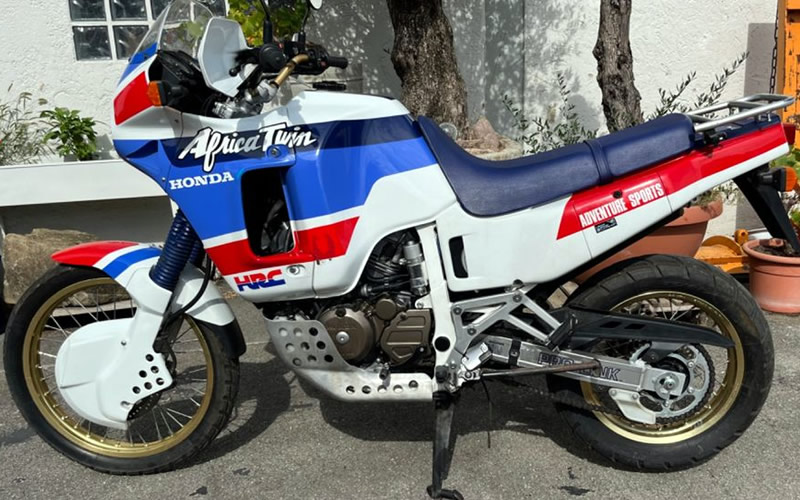
XRV 650, 1989 year, left view
Derived from the Honda XL600V Transalp and powered by the V-twin engine from the Honda NT650 Falco, it was an enduro driven by a 647 cm³ engine. In Germany, due to the homologation legislation in effect at the time, the power was reduced from 57 hp to 50 hp.
The aluminum rims had steel spokes mounted on cross-ply tires both front and rear. The RD 03 had a braking system consisting of a single perforated disc brake with a two-piston caliper at the front, while at the rear there was a disc brake with a single-piston caliper. The motorcycle was only available in the Honda Racing Corporation (HRC) color combination of white-red-blue.
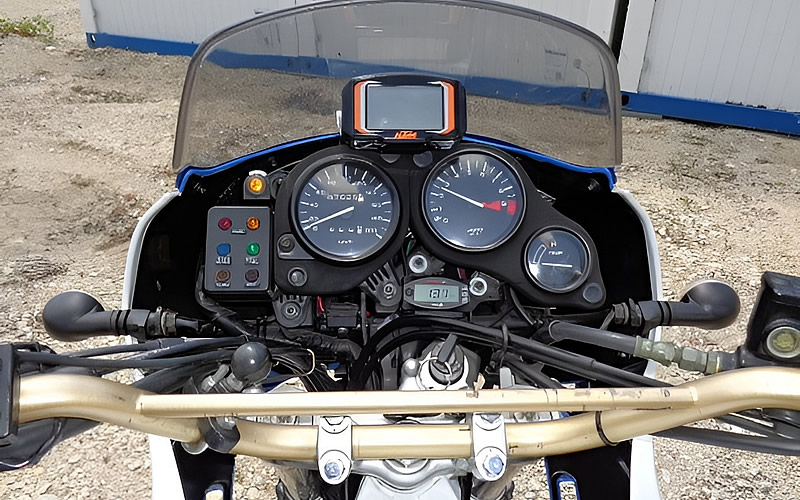
XRV 650, 1987 year, dashboard
The liquid-cooled four-stroke engine was mounted transversely in the frame, so that the two cylinders of the V-engine were positioned one behind the other with an angle of 52° between the banks relative to the crankshaft. The two cylinders had a bore of 79 mm, a stroke of 66 mm, and a compression ratio of 9.4:1. Each cylinder head had a single overhead camshaft driven by a chain, which controlled one exhaust valve and two intake valves. The crankshaft transmitted power through an oil-bath multi-plate clutch to a five-speed transmission, connected to the rear wheel via a chain.
The frame was made of tubular steel with a double top section constructed from rectangular profiles. The two stanchions of the front telescopic fork had a diameter of 43 mm and a spring travel of 230 mm.
The engine was cooled with a mixture of water and antifreeze, which dissipated the heat from the combustion of the two cylinders through two radiators; the thermostat would fully open only at an operating temperature of 95°C. The right radiator is equipped with a cooling fan that activates when the liquid temperatures exceed 100°C.
Honda XRV750 (1989-2003)
The Honda XRV 750, also known as the Honda XRV 750 Africa Twin, is an enduro motorcycle produced by the Japanese motorcycle manufacturer Honda Motor Co. Ltd. from December 1989 to 2003.
The XRV750 Africa Twin was an enduro powered by a 742 cm³ engine, first introduced in December 1989 and based on the Honda NXR 750, which won the Paris-Dakar Rally four times at the end of the 1980s (from 1986 to 1989).
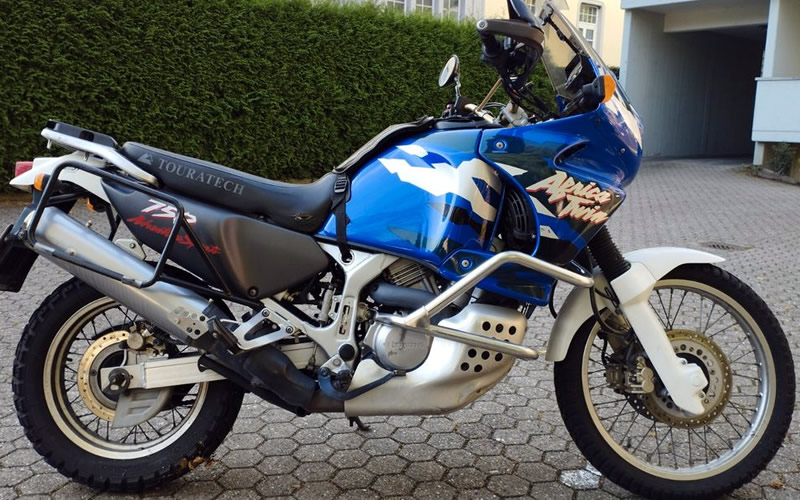
XRV 750, 1999 year, right view
Built as a tribute to the motorcycles used in the Paris-Dakar Rally, the Africa Twin was powered by a V-twin engine with a 52° angle between the banks. Externally, it featured two round headlights, a small windshield, a long seat extending from the fuel tank to the aluminum grab handle, and a plastic-coated luggage rack. Additionally, there was an aluminum skid plate to protect the lower part of the engine from rocks and impacts.
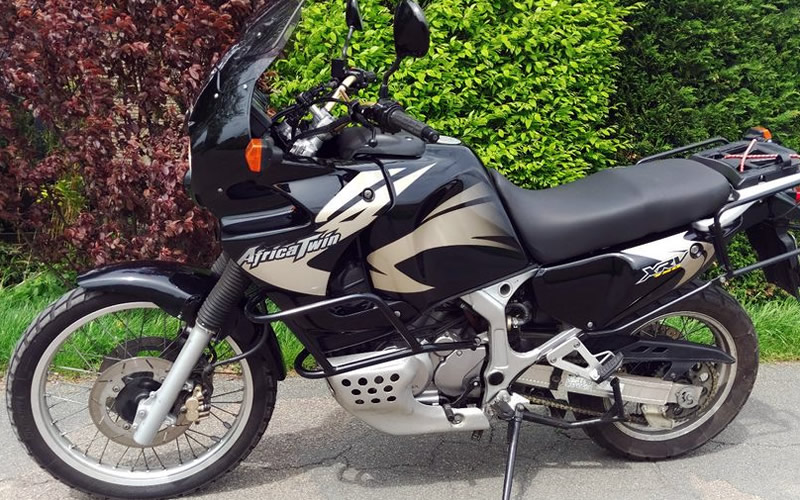
XRV 750, 2002 year, left view
The 742 cm³ liquid-cooled four-stroke V2 engine had a unique SOHC valve arrangement with 6 valves (3 per cylinder) and a dual ignition system with four spark plugs (two per cylinder). The front suspension consisted of a long-travel telescopic fork specifically designed for off-road use. The brakes were dual discs at the front and a single disc at the rear.
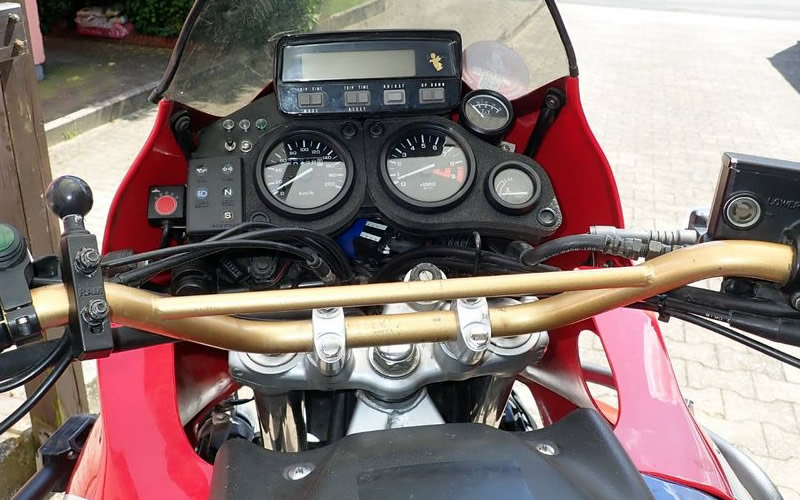
XRV 750, 2001 year, dashboard
In 1990, it underwent a minor update. In 1992, a trip computer called the Tripmaster was added. The XRV's instrumentation was equipped with a large LCD display mounted above the analog speedometer and tachometer, similar to the navigation displays used by Dakar riders, which incorporated an electronic timer and a partial odometer. In 1993, the motorcycle underwent a significant redesign that included a new frame, new plastic body parts and fuel tank, modifications to the engine, and a lowered seat; there was a slight increase in weight. In 1996, the seat was modified, the clutch was improved, a larger silencer was installed, new upper fairings were added, and a new luggage rack was introduced; the rear shock absorber was no longer adjustable as in previous versions.
Honda CRF1000L (2015-2020)
The Honda CRF 1000L, also known as the Honda CRF 1000L Africa Twin, is a road enduro motorcycle produced by the Japanese motorcycle manufacturer Honda Motor Co. Ltd. from 2015 to 2020.
Announced in May and with some technical data released in July at EICMA 2015, the CRF 1000L was officially presented, reviving the "historic" Africa Twin name after more than a decade since the last model, the XRV 750, went out of production.
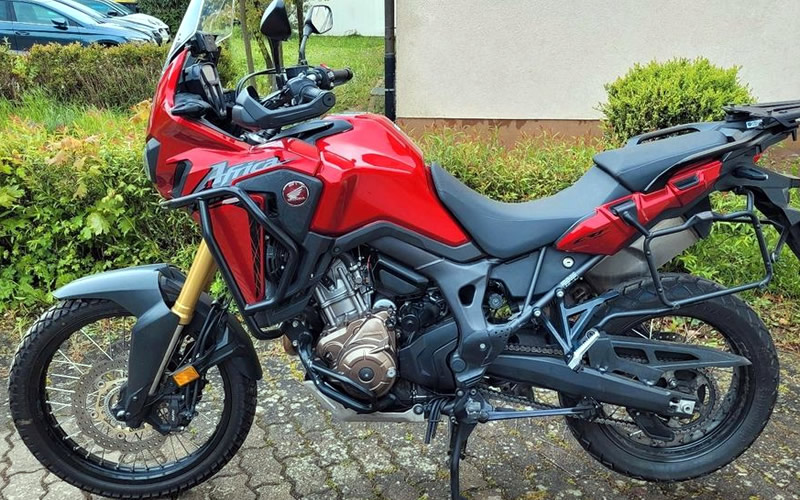
CRF 1000L, 2017 year, left view
Although the launch occurred at the end of 2015, this motorcycle was homologated as Euro 3, and it was later updated to Euro 4 in early 2017.
This model features a newly designed 998 cm³ engine producing 95 hp and 98 Nm of torque, and it offers three base configurations along with multiple color variations and accessories. The most innovative feature is the option for a fully automatic dual-clutch transmission (DCT) with specific programming for off-road use. For road code and driver's license purposes, this version is classified as "Automatic".
The presented versions are:
- Base: Without electronic assistance, with a reduced accessory package and a mechanical transmission.
- ABS: Equipped with ABS, traction control, and a mechanical transmission.
- DCT: With the same electronics and accessories as the previous version but with an automatic Dual Clutch Transmission.
The base model was removed from the lineup in January 2017 due to the European requirement for ABS installation (and compliance with Euro 4 standards) for new registrations.
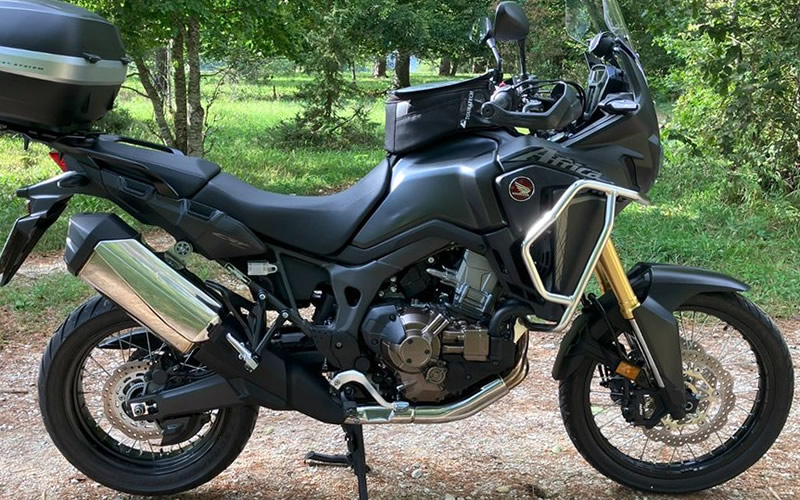
CRF 1000L, 2016 year, right view
Honda homologated the CRF 1000L with speed class "H" tires (equivalent to 210 km/h) but provides, upon request, approval to install tires suitable for off-road use starting from speed code "Q" (i.e., from 160 km/h), and since the installation of M+S tires with lower speed codes is permitted, a variety of tire types can be chosen.
At EICMA 2017, Honda presented a general renewal of the existing range along with a new model that directly references the historic NXR version from 1988, later marketed as RD03. This version is called "Adventure Sports", just like the XRV 650, and it recalls both the color schemes and the 30th anniversary with a sticker on the fuel tank.
This version retains all the improvements present in the 2018 models while adding distinctive elements, including a larger fuel tank (24 liters instead of 18), increased suspension travel, a steel luggage rack reminiscent of the historic model, heated grips, and standard steel protection tubes.

CRF 1000L, 2018 year, dashboard
Various improvements across the range include the engine (with a lighter crankshaft and larger air intakes) that, while maintaining the same power, offers better response at low and mid-range RPMs, revised instrumentation (still with a passive display, which is not exceptional for off-road use), a more "open" exhaust that generates a sound more suited to the type of motorcycle, steel footpeg mounts (instead of aluminum) and larger footpegs (better for off-road use), a Throttle-By-Wire system that also allows for the availability of 4 mappings that adjust power (across 3 levels), engine braking (across 3 levels), and traction control (now across 7 levels); 3 of these maps are defined by the manufacturer, although they can be modified during riding, and one can be configured by the rider. Some features are aimed at safety, such as "panic stop", which causes the turn signals to flash rapidly in case of sudden braking, and automatic turn signal deactivation when going straight. Stainless steel spokes and the homologation of road tires and M+S tires complete the modifications.
Among the options is the Quickshifter, a gear shift assistant (also programmable by the rider with three levels for downshifting and three for upshifting) that facilitates use without engaging the clutch.
Honda CRF1100L (2020-current)
In 2020, Honda launched the CRF1100L, marking a significant overhaul of the motorcycle. This new iteration features a completely redesigned engine, suspension, frame, and swingarm, alongside a state-of-the-art instrument display and rider interface. A key enhancement is the introduction of a six-axis Inertial Measurement Unit (IMU), which provides comprehensive data and a variety of ride modes, including wheelie control and torque management. The updated rider interface boasts additional data screens, Bluetooth connectivity, and support for Apple CarPlay. Additionally, cruise control has been integrated and is easily managed through the rider interface.
The Adventure Sports variant saw its height reduced to align with that of the standard model. It also received electronically adjustable suspension and tubeless rims, enhancing its versatility and comfort.
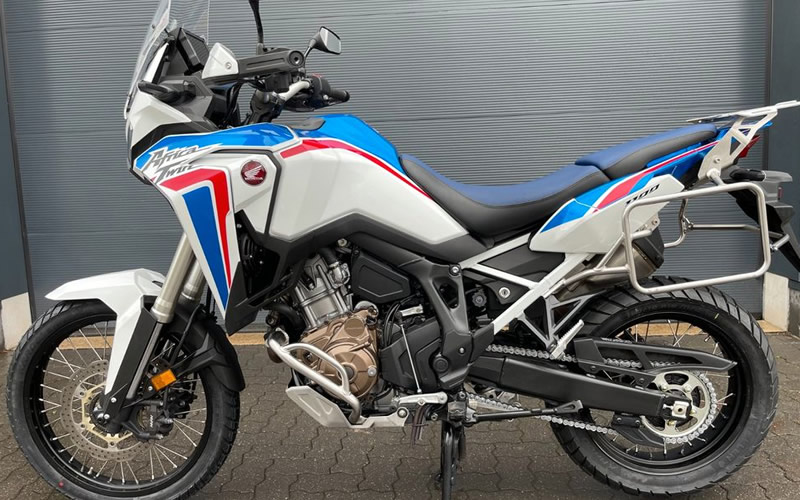
CRF 1100L, 2021 year, left view
The new engine boasts a displacement of 1084 cc, an increase from the previous 998 cc. This improvement includes a 6.5 mm increase in stroke, along with new pistons, a redesigned crankshaft, and camshafts that feature extended intake and exhaust valve lifts (with the intake lift rising from 9.2 mm to 10.1 mm and the exhaust from 8.6 mm to 9.3 mm). The throttle body has been enlarged to 46 mm, the intake tract has been optimized for airflow, and the ECU has undergone new fueling mapping for enhanced performance.
In late 2021, Honda issued a software update that added Android Auto compatibility to the 2020 and 2021 models, which initially only supported Apple CarPlay.
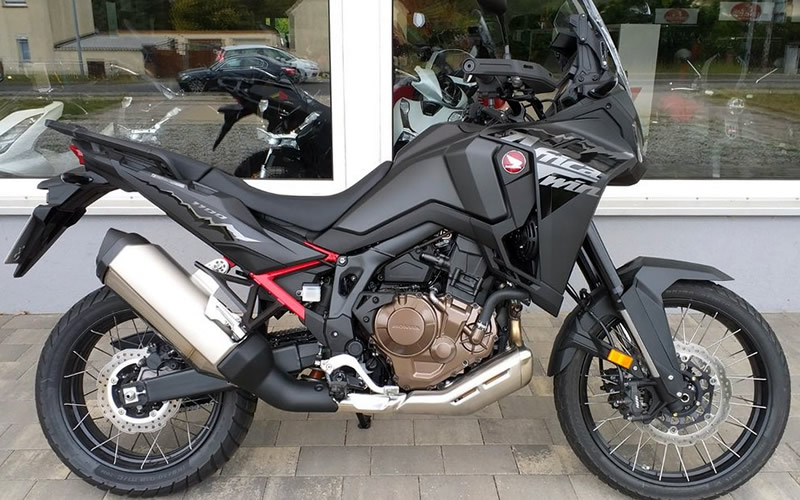
CRF 1100L, 2024 year, right view
The 2022 model year brought with it subtle but notable changes. Both the standard and Adventure Sports versions received fresh color schemes and graphics. The standard model now comes equipped with a rear aluminum luggage rack that was previously exclusive to the Adventure Sports variant. The Adventure Sports model features a new windscreen that is 110 mm shorter, offering improved visibility and five adjustable positions.
The DCT (Dual Clutch Transmission) has been refined, with optimized first and second gears for smoother starts and better low-speed handling. Honda continues to invest in the DCT option, which accounted for 47% of sales in 2020.
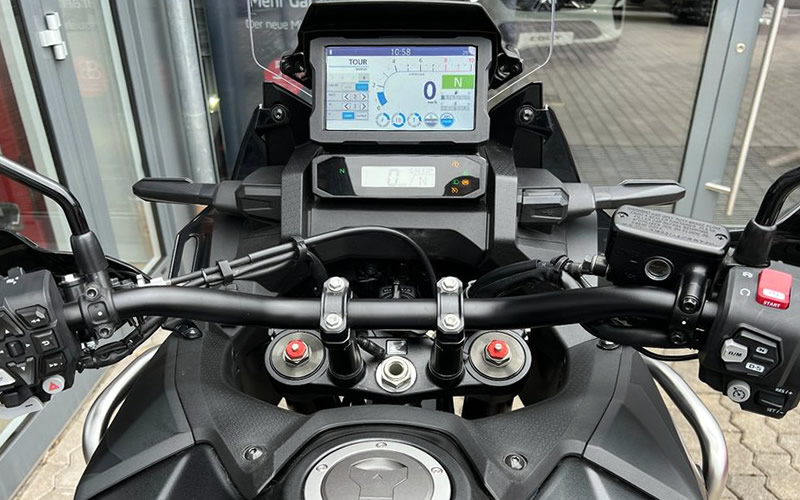
CRF 1100L, 2022 year, dashboard
For 2023, the Africa Twin remains largely unchanged aside from new color options, including Matte Ballistic Black Metallic, Glint Wave Blue Metallic Tricolor, and the returning Grand Prix Red.
Looking ahead to 2024, both the Africa Twin and Adventure Sports models will undergo a "significant makeover". While the engine remains the same 1084 cc parallel twin, the compression ratio has been increased from 10.1:1 to 10.5:1. This change, along with adjustments to valve timing, intake ports, and ECU settings, results in a 7% increase in maximum torque, now reaching 112 Nm at 5500 rpm — delivered earlier than the previous peak at 6250 rpm. The models will also feature a new muffler and enhancements to the DCT shifting, particularly at low speeds and during cornering. The front fairings have been redesigned to improve aerodynamics and wind deflection. The base model (non-AS) ES trim will now include heated grips and a charging socket, with the option for Showa EERA electronic suspension, previously exclusive to the Adventure Sports model.
- Information for owner
- Introduction to manual
- Weekly checks
- Maintenance
- Troubleshooting
- Engine and systems
- Engine repair
- Transmission
- Cooling system
- Fuel and exhaust systems
- Ignition system
- Running gear and frame
- Brake system
- Wheels and tires
- Frame and hinged elements
- Electric equipment
- Equipment and devices
- Lighting and lamps
- Starting and charging system
- Electrical circuits
